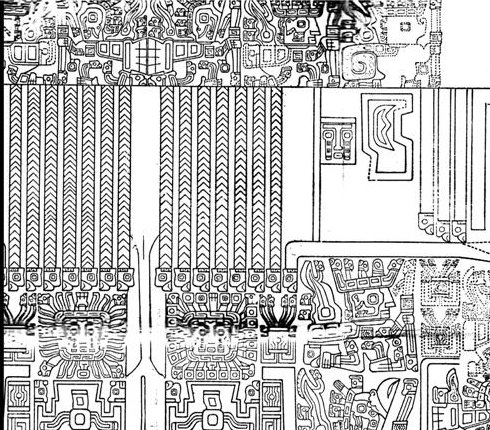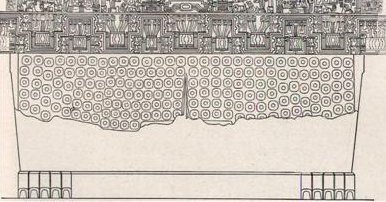The Pachamama statue has at her back information which could confirm my general idea, viz. that there was a division of the number of nights determined by when the sky was high respectively when sky was low (i.e. 'together with earth in close embrace').
... Savage tribes knew the Pleiades familiarly, as well as did the people of ancient and modern civilization; and Ellis wrote of the natives of the Society and Tonga Islands, who called these stars Matarii, the Little Eyes: The two seasons of the year were divided by the Pleiades; the first, Matarii i nia, the Pleiades Above, commenced when, in the evening, those stars appeared on the horizon, and continued while, after sunset, they were above. The other season, Matarii i raro, the Pleiades Below, began when, at sunset, they ceased to be visible, and continued till, in the evening, they appeared again above the horizon. Gill gives a similar story from the Hervey group, where the Little Eyes are Matariki, and at one time but a single star, so bright that their god Tane in envy got hold of Aumea, our Aldebaran, and, accompanied by Mere, our Sirius, chased the offender, who took refuge in a stream. Mere, however, drained off the water, and Tane hurled Aumea at the fugitive, breaking him into the six pieces that we now see, whence the native name for the fragments, Tauono, the Six, quoted by Flammarion as Tau, both titles singularly like the Latin Taurus. They were the favorite one of the various avelas, or guides at sea in night voyages from one island to another; and, as opening the year, objects of worship down to 1857, when Christianity prevailed throughout these islands.
Below her right side tresses (ca 185 in measure) there is a face surrounded by 'watery' Sun symbols - of the same general type as in her skirt (with a pair of exceptions) - and below her left side tresses (ca 215 in measure) there is another face surrounded by what looks like feathers:
In the corner positions of the right side face there are bird heads and in the corner positions of the left side face there are mammal heads. Sky (185) respectively Earth (215). Further down and in the center there is a standing great figure who seems to encompass the whole:
Like in the tresses of Pachamama the left-right symmetry is only illusive. Already in the central 'arrow tree' above his head we can clearly see how the left side of the 'arrow tail' is narrow compared to its right hand side (maybe in order to allude to the feathers around the face at left above). A pair of great bird heads are to the right of this 'arrow tail' and a pair of mammal heads to the left. And his hands are revealing. There is a thumb on his left hand but not on his right. This thumb could be a 'picture play' alluding to the nose on the mammal heads. A nose means 'in front'. Possibly this great figure has his arms held high in a greeting gesture: "We had many of the Natives went with us a cross the Isthmus [from Hanga Roa bay to the east coast] and one man constantly kept a head of us carrying a white flag who seem'd to direct the crowd ... From this place [at the eastern sea-border] we traveled about 3 miles further a long shore, the man still carrying his flag and the Natives flocking round us to about 150 in Number; this part of th Country was very barren, hardly a house or Plantation to be seen and the rocks seem'd to contain Iron ore [wrong guess]; here the Path struck up a little from the Sea side and we pass'd some Plantations where the people behaved exceedingly civil, bring us dress'd Potatoes and plenty of Sugr Cane but we could get no water but what was brackish. After passing this valley we saw a number of men collected upon a hill some distance from us and some with spears but on the people which were with us calling to them they dispers'd except a few amongst which was a man seemingly of some note, he was a stout made man with a fine open countenance, his face painted, his body tatowed and some thing whiter than the rest and he wore a better ah-hou, with both hands clinch'd lifting them over his head, opening them wide and leting them fall gradually down to his sides, they told us he was the arekee of the Island which they call'd Wy-hu, this they seem'd all to agree in." (J. C. Beaglehole, The Voyage of the Resolution and Adventure 1772-1775.) Fires flow out from his toes and he seems to be standing on Earth (we can guess from the pair of mammal heads on the foundation and from the double pair of such held high). Below him could be the 'crust of the Earth', like a band of 'stations', and even further down Water - like in a rock-filled bath tub standing on feet:
... Water accumulates at bottom and below the midline of Pachamama these symbols probably are meant to indicate water, but their arrangement and their number (94 + 83 = 177) implies that each of them probably represents a day. Thus this type of symbol can also represent Sun beyond midsummer ... |

.jpg)
